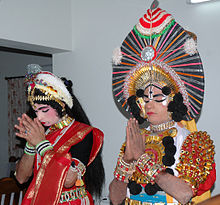This is an old revision of this page, as edited by Uttam h (talk | contribs) at 13:31, 21 September 2004. The present address (URL) is a permanent link to this revision, which may differ significantly from the current revision.
Revision as of 13:31, 21 September 2004 by Uttam h (talk | contribs)(diff) ← Previous revision | Latest revision (diff) | Newer revision → (diff)Mangalore is the chief port city of the state of Karnataka, India. It is the capital of Dakshina Kannada District.
It lies on the coast of the Arabian Sea, and is known for its beaches, temples and industries.
Notable among Mangalore's industries is the refinery.
The main languages of Mangalore are Tulu, Kannada and Konkani.
Mangalore receives very heavy rains during monsoon period between June to September around 4000mm.
Lying in the Western coast and touching the Arabian Sea, Mangalore has been historically a ship building centre. Being a strategic port it was always under conflict in the past, thus having been under several varied dynasties Mangalore today is a blend of the new and old. Tulunadu is one of the most enchanting place to travel. Though known for its religious places of worship, the place is blessed with green fields, water falls, beautiful beaches and with rich variety of flora and fauna.
Mangalore was named after the goddess Mangaladevi. The story behind goes along way in enriching the cultural heritage of Mangalore. Mangalore is the administrative headquarters of Dakshina Kannada district, southwestern Karnataka (formerly Mysore) state, southern India, a port on the Arabian Sea. It is also one the major ports of India. Lying on the backwaters formed by the Netravati and Gurpur rivers, it has long been a roadstead along the Malabar Coast. Engaged in Persian Gulf trade in the 14th century, Mangalore was occupied by the Portuguese in the mid-16th century. In the 18th century its control was contested by Haidar Ali and Tipu Sultan on one hand and the British on the other. Under the Mysore sultans (1763) it became a strategic ship building base, which was ceded to the British in 1799 after numerous sieges.
The modern port 10 km north of the town, is now India’s ninth largest cargo handling port. Mangalore's economy is dominated by agricultural processing and port-related activities. Imports include tropical timber from south-east Asia for furniture making, a necessity since India places major restrictions on its own teak felling. The port handles 75% of India’s coffee exports and the bulk of it cashew nuts. The latter are brought from many coastal areas (notably from Kerala, where 90% of India’s cashews are grown); the National Cashew research centre is near by at Puttur.
It has several famous pilgrim centres. The district is a leader in more than one way in banking, private entrepreneur-ship and in general awareness amongst people. The city of Mangalore has given birth to four nationalised banks apart from general insurance companies. Critics call it the Cradle of Banking Industry. It has an airport and an all-weather port and is well connected with other parts of the country. Industrialisation has crept in, in the form of the Mangalore Chemicals and Fertilizers Limited, Kudremukh Iron Ore Company Limited, Mangalore Refinery and Petrochemicals Limited, National Thermal Power Corporation Limited, Infosys Ltd. and a host of other projects proposed for the district, such as the power plants of Jaiprakash Industries and NTPC, downstream units of MRPL, etc.
The tile, coffee and cashewnut factories are a unique sight limited to the whereabouts of this coastal town. The St. Aloysius Chapel with its 100 years old paintings, Shrimati Bai Memorial Museum, Beedi Factories, historical temples, historical forts, Saib Mosque and Music Gallery is worth watching.
A trip to Mangalore is incomplete without watching the Classic Yakshagana - an elaborate dance - drama performance unique to Karnataka. A night-long event, with people adorned vibrantly, and dancing to the beat of drums, Yakshagana performance attracts thousands of people.
Hulivesha (Tiger dance) is a unique form of folk dance in Dakshina kannada that fascinates the young and the old alike. Since tiger is considered as the favored carrier of Goddess Sharada (the deity in whose honor Dussera is celebrated), this dance is performed during the Dussera celebration. It is also performed during other festivals like Krishna Janmasthami.
|
|
 |
Attractions
- Mangala Devi Temple.
- Kadri Manjunath Temple.
|
|
- Shri Sharavu Mahaganapathi Temple.
- New Mangalore port.
- Panambur Beach.
- Tannirubhavi Beach.
- Light House Hill.
- St Aloysius Church.
- Rosario Church.
- Milagres Church.
- Seemanthi Bai Museum.
- Kadri Park.
Major Industries
- Mangalore Refinaries and Petrochemical Ltd(MRPL).
- Mangalore Chemicals and Fertilizars(MCF).
Nearby Places
- Udupi Shree Krishna Temple.
- Malpe Beach.
- Kaupu Light House.
- Dharmasthala.
Major Educational Institutions
- National Institute of Technology,Surathkal.
- Kasturba Medical College.